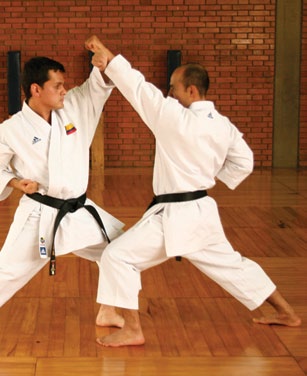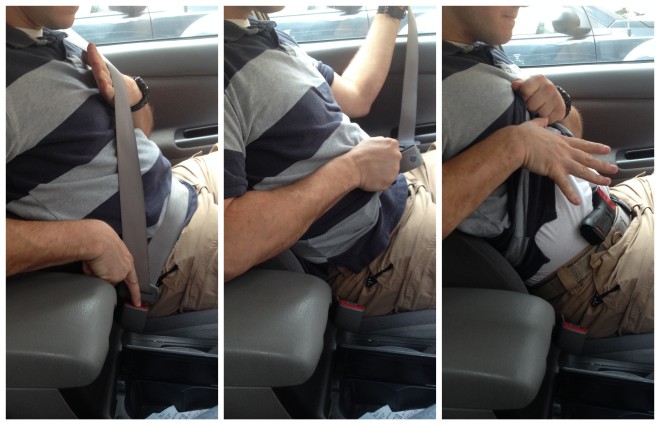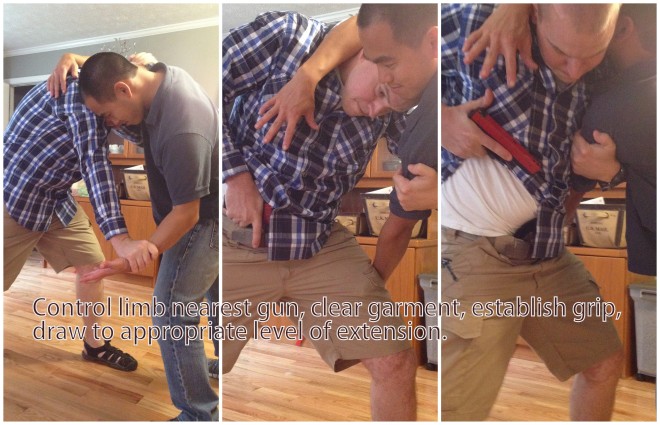In the second installment of this series, we will discuss the how of increasing your home security. I’ll be talking about how to use the diagram that you made in the first article. We will talk about how to negate the weak points of your house’s layout, and light up the dark spots. We will list some inexpensive physical security upgrades, early warning methods, and some ideas about how to project the illusion of extra security when you might not actually have it. Remember that our goal is to appear to be a harder target than the folks next door (sorry neighbor Bob). Everything I mention in this article are things I have done to my home. All of the upgrades are budget minded and doing all of them totals less than $250.
I knew my home was projecting the appearance of security when my neighbors reminded me this was a ‘good neighborhood’ and asked why I had my house lit up like a Christmas tree at night.

We want our homes to appear unappealing from the street, unappealing from close up, be difficult to enter by actually reinforcing entry points, have early warning systems in place to alert us to intruders, and we need to have a ‘safe room’ and a plan established to fall back to if all of the precaution fails. Let’s build our layers of security for the home.

Layer 1: From the Street
Like we read about in the interviews with burglars, the first thing bad guys look for is the appearance of alarm systems. Some then test to see if there is actually an alarm system and will abort the burglary immediately if an alarm is triggered. As a result, you should either go all the way and get an alarm system installed, with battery backup and SMS cell tower dial-out so that power outage or a phone line being cut don’t affect the police being called. Barring this, start by purchasing security system signs and decals. Put the big sign by the mailbox and paste the stickers on windows and doors on ground level.
Keep your shrubs and hedges trimmed in such a way that there are no hiding spots from the road. If you have a basement window that is hidden by a thick bush, it makes a great entry point because it conceals the burglar’s movements. Keep things trimmed up. If you can’t, you should consider planting bushes that have thorns and would make crawling past uncomfortable. I cut down a large decorative tree that was obscuring the front door from the street (not to mention it was ugly) and the wife and I purchased bushes that we could keep under control while still looking nice.

Use the lighting diagram you made from the last post to find the darkest parts of your house. If there are entry points there, fix that. Purchase motion sensing flood lights and install them. You should light the dark areas whether you can see the areas they illuminate or not. They are simple to install, just make sure you don’t zap yourself. If you happen to have an area that doesn’t have an existing fixture, the MicroSolar Outdoor Solar Motion Sensor Lightis outstanding. I installed one in the dark zone of my home and it’s bright and waterproof. I highly recommend it. We’re livin’ in the future, I tell you…

If you want to get fancy, you can buy Security Cameras and mount cameras to monitor your home 24/7. When I was in Atlanta, I had a four camera system. Two of the cameras monitored the street in both directions, one camera watched the front door, and the last camera watched that camera and the front windows to make sure no one tampered with the door camera. I recall at least two occasions where casual passersby noticed the cameras and started talking about it to themselves. I was glad they noticed them. Being obvious is good.
My neighbors didn’t have any installed, and a wannabe home invader nearly broke past the front door when they opened it for them (reminder: you don’t have to open the door just because someone knocks). I’m not saying it prevented an attempt on my house, but I know that no home invaders tried to push past my wife into the house as they did to the neighbors. If you want to go more budget minded, you can buy a few Dummy Security Cameras and put them in obvious places visible from the street. I would try to make the dummy cameras obvious, but with the real cameras I’d be more strategic so that they aren’t easy to disable without being seen by another camera. Think interlocking fields of fire.
Layer 2: From Up Close
Here are some ideas that will help if the first line of deterrence fails. These are things meant to deter if someone is in close proximity to the house and possibly peeking past blinds and attempting a rouse to see who might be home before doing the deed.
Have sheer blinds on the ground level at a minimum. No one should have unfettered visual access to your house. Window shopping is fine at the mall, not at my house.
Having a dog is a great idea. More dogs is more better. They give good kisses, they’re loyal to the death, they will keep you warm on the couch, and a barking dog is a well known deterrent for burglary. I would suggest you not get a dog only for home defense, because they get expensive. I really am quite fond of ours. Consider that a burglar might check to see what parts of your house the dogs can’t get to and break in there. That’s just something to think about.

If you don’t want a dog, then why not make it seem like you have a dog? Get a well chewed toy from a friend’s dog, a water bowl, and maybe a ‘Beware Of Dog’ Sign and hang it on the fence. Plant the seed of doubt in the bad guy’s mind.
Get an old radio and a lamp and put them on a cheapo Lighting Timer. Have the radio play during the day and the light come on a few times at night. Most burglars don’t want to tangle with the home owner.
Don’t leave the tools of the trade laying around your house. The ladder under your porch? That makes a great escalator to reach your second story. The hammer you left by the garage? Universal key. Don’t make it easier for them. Put a bike chain on the ladder rungs and lock it to your porch. Clean up your tools.
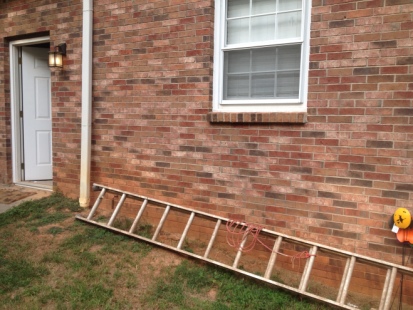
Layer 3: Physically Harden the Entrances
If you have old style wooden framed windows, Security Pins are cheap and easy reinforcement. All you need to install them is a drill. If you have newer vinyl windows, Vinyl Window Lock simply tighten to the track, and prevent movement of the window. Be sure to keep the key to the pins on the top of the frame of the windows so in case you need to open the windows in a hurry (FIRE) you can.
If you have deadbolts, be sure the ones near windows are keyed and you remove the keys when not in use. Being able to smash the window and unlock the deadbolt sort of defeats the purpose.
Consider removing or putting a security film on the windows of your garage.
Installing Security Strike plates is another simple upgrade that anyone can do. I had no trouble completing the job using a drill and a dremel tool. Make sure you match the existing hardware colors, because wives don’t like mismatched door hardware (ask me how I know). I have read in several places that the average amount of time a burglar spends trying to gain entry is about 60 seconds, then they lose interest and look for greener pastures. The increased number of longer screws and thicker gauge metal should both help to slow entry. This buys you time if you’re home during the break-in and might make a burglar fear too much attention if he has to keep kicking the door if you’re not home.
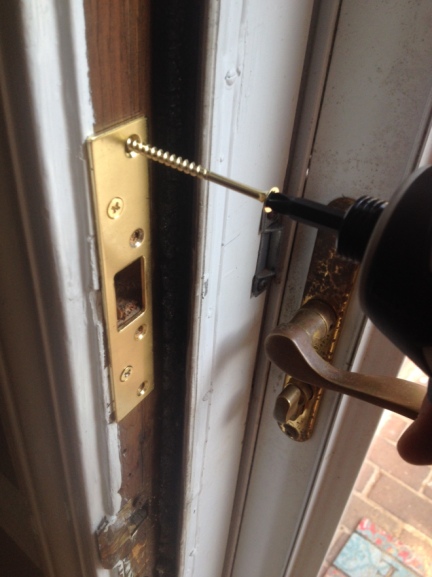
Layer 4: Early Warnings
Let’s say today is your day. The guy is coming in, brought the right tools to defeat your reinforcements (or you left something unlocked or wide open), and found a door that your dogs can’t reach. If you have a monitored alarm system, hopefully this is where that takes over and the coppers are on the way. A huge fear of mine is waking up and the bad guys are right outside the bedroom. The lack of time makes my palms sweat. That would be a bad day. Let’s say you don’t have the option of a monitored alarm system. What can you do?
Put an old baby monitor in a distant room, and the receiver in your bed room. If someone starts shuffling around in the garage or basement, you’ll hear it. Plenty of time to get the cops on the line and get your gear on.
This Security Alarm Kit is great both as a deterrent and as an early warning. They are LOUD. The units work via a magnet that keeps the alarm silent when it’s next to the unit, and sets it off when it’s separated. It will shut off as soon as the magnet is put back in place. My personal hope is that as soon as the 120 dB alarm starts blaring, the bad guy remembers a previous engagement and leaves. I have several of these strategically placed in the remote areas of my house and I can hear them from anywhere in the house. I’m really pleased with these so far. They also work well for apartments or dorm rooms. Recommended.
Place a convex mirror (I used a baby car mirror) outside of your front door, where you can see it from your peephole. Put it in a place that allows you to see the blind spot to the immediate left and right of your door. Being able to see 180 degrees outside of your front door gets rid of any hiding spots that someone could use for an ambush when you open the door for that nice gentleman who needs to use a phone.

Layer 5: The Safe Room
We’ve discussed this briefly in previous posts. There’s also many resources about this online. Do some googling and reading.
Layer 6: You
I’d be remiss if I didn’t remind you that in order for all of this gear to work, you have to have the Mindset to implement it. You have to have the presence of mind to set your alarms, change the batteries, lock the doors, not open the door for just anybody, not leave the new flat screen TV box visible to all passersby on trash day, create plans and train your family, and so on. We are usually our home’s biggest security weakness. Be a tougher nut to crack.
Protect the Brood,
Defensive Daddy.




